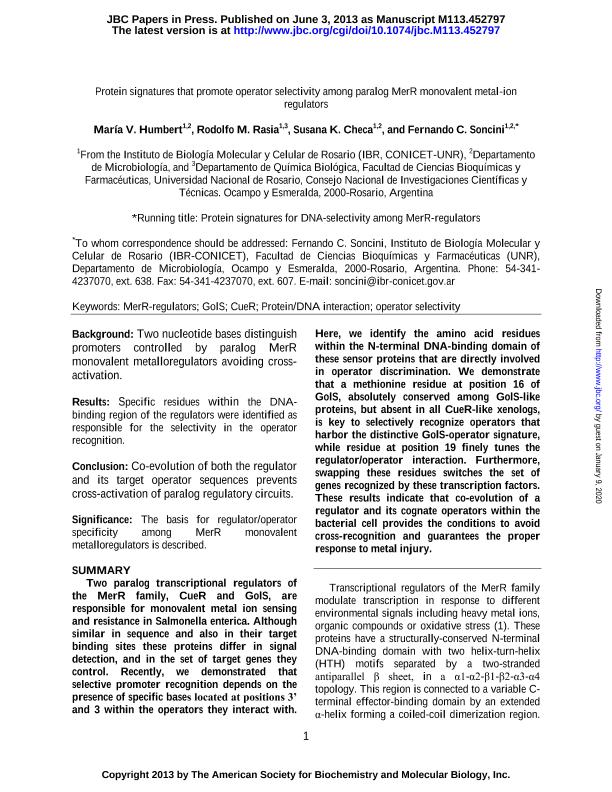Artículo
Protein signatures that promote operator selectivity among paralog MerR monovalent metal ion regulators
Humbert, María Victoria ; Rasia, Rodolfo Maximiliano
; Rasia, Rodolfo Maximiliano ; Checa, Susana Karina
; Checa, Susana Karina ; Soncini, Fernando Carlos
; Soncini, Fernando Carlos
 ; Rasia, Rodolfo Maximiliano
; Rasia, Rodolfo Maximiliano ; Checa, Susana Karina
; Checa, Susana Karina ; Soncini, Fernando Carlos
; Soncini, Fernando Carlos
Fecha de publicación:
07/2013
Editorial:
American Society for Biochemistry and Molecular Biology
Revista:
Journal of Biological Chemistry (online)
ISSN:
0021-9258
Idioma:
Inglés
Tipo de recurso:
Artículo publicado
Clasificación temática:
Resumen
Two paralog transcriptional regulators of the MerR family, CueR and GolS, are responsible for monovalent metal ion sensing and resistance in Salmonella enterica. Although similar in sequence and also in their target binding sites, these proteins differ in signal detection and in the set of target genes they control. Recently, we demonstrated that selective promoter recognition depends on the presence of specific bases located at positions 3′ and 3 within the operators they interact with. Here, we identify the amino acid residues within the N-terminal DNA-binding domain of these sensor proteins that are directly involved in operator discrimination. We demonstrate that a methionine residue at position 16 of GolS, absolutely conserved among GolS-like proteins but absent in all CueR-like xenologs, is the key to selectively recognize operators that harbor the distinctive GolS-operator signature, whereas the residue at position 19 finely tunes the regulator/operator interaction. Furthermore, swapping these residues switches the set of genes recognized by these transcription factors. These results indicate that co-evolution of a regulator and its cognate operators within the bacterial cell provides the conditions to avoid cross-recognition and guarantees the proper response to metal injury.
Archivos asociados
Licencia
Identificadores
Colecciones
Articulos(IBR)
Articulos de INST.DE BIOLOGIA MOLECULAR Y CELULAR DE ROSARIO
Articulos de INST.DE BIOLOGIA MOLECULAR Y CELULAR DE ROSARIO
Citación
Humbert, María Victoria; Rasia, Rodolfo Maximiliano; Checa, Susana Karina; Soncini, Fernando Carlos; Protein signatures that promote operator selectivity among paralog MerR monovalent metal ion regulators; American Society for Biochemistry and Molecular Biology; Journal of Biological Chemistry (online); 288; 28; 7-2013; 20510-20519
Compartir
Altmétricas



